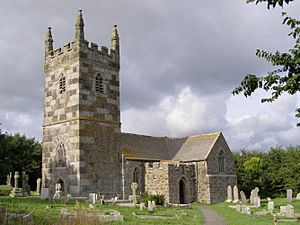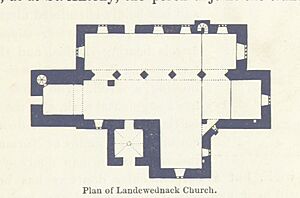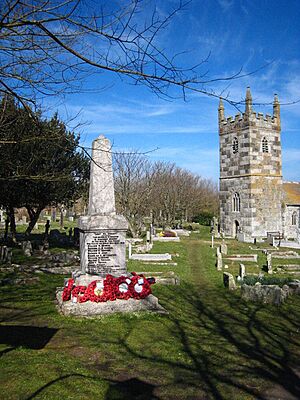St Wynwallow's Church, Landewednack facts for kids
Quick facts for kids St Wynwallow's Church, Landewednack |
|
|---|---|

St Wynwallow's Church
|
|
| 49°58′14″N 05°11′36″W / 49.97056°N 5.19333°W | |
| OS grid reference | SW 711 127 |
| Denomination | Church of England |
| Churchmanship | Broad Church |
| History | |
| Dedication | St Wynwallow |
| Administration | |
| Parish | Landewednack |
| Archdeaconry | Cornwall |
| Diocese | Truro |
| Province | Canterbury |
St Wynwallow's Church, Landewednack is a historic church in Landewednack, Cornwall, England. It belongs to the Church of England and serves the local community. This church is special because it's the most southerly church on mainland Britain. It is located about 16 kilometers (10 miles) south of Helston.
The church was first started around the year 600 AD. The oldest parts of the building you see today were built in the 11th century.
Contents
Exploring the Church Building
Who is St Wynwallow?
The church is named after Saint Winwaloe. He was the third son of a Cornish family who moved to Brittany, a region in France. There, he founded a monastery called Landévennec. We don't have proof that he ever visited Cornwall himself. It's possible the church was started by one of the monks from his monastery, or even by his older brother, Wennac. Nothing from the very first church building remains today.
Oldest Parts of the Church
The oldest part of the current church building is the south doorway. It was built in the 11th century in the Norman style. This doorway features columns made of a dark green rock called serpentinite.
This Norman doorway is now inside a larger south porch. This porch was added later, either in the 13th or 14th century, and is built in the Gothic style. It has a special arched ceiling called a rib vault.
The church also has a south transept, which is like a wing extending from the main part of the church. Its east window dates back to the 13th century. You can also find 13th-century piscinas (small basins used for washing sacred vessels) in the chancel (the area around the altar) and the south transept. There's even a hagioscope, which is a small opening that allowed people in the transept to see the altar in the chancel.
The West Tower and Font
The tall west tower of the church was rebuilt in the early 15th century. It's made from a mix of granite and serpentinite blocks, placed randomly.
The font, used for baptisms, is made of granite. It has an old inscription that says "IHC and D RIC BOLHAM ME FECIT c1404". This means "Jesus and Richard Bolham made me around 1404". Richard Bolham was the Rector (a type of priest) of the church from 1404 to 1442. The font sits on four small shafts added in the 19th century.
Later Additions and Changes
An important addition was the north aisle, which has five sections. This was built in the early 16th century. Its east and north windows are in the Perpendicular Gothic style, known for its tall, narrow panels of tracery. The south window of the south transept and the west window of the west tower also show this Perpendicular style.
The church underwent a major restoration in the 1860s. During this time, the base of the serpentinite pulpit (where sermons are given) was added in 1860. A Victorian lectern, made of shiny serpentinite, was also installed. Other 19th-century features include the glass in some of the north aisle windows. The restoration also removed a rood screen and rood loft, which used to separate the chancel from the main part of the church. The vestry, a room used by the clergy, was added in the 20th century. Today, the building is a Grade I listed site, meaning it's very important historically.
Church Bells
The west tower of St Wynwallow's Church has a set of six bells. These bells are arranged for change ringing, a special way of ringing bells in a sequence.
One of the oldest church bells in Cornwall is the fifth bell here. It was cast by William Chamberlain in London around 1456. Two other bells, the current fourth bell and a tenor bell, were cast by Thomas Bullisdon in London around 1515. The older tenor bell is no longer used for ringing and is displayed on the church floor.
In 1937, a company called John Taylor & Co from Loughborough made four new bells for the church. These include the tenor bell currently in use, and the first, second, and third bells. It's quite unusual that the 15th-century fifth bell is heavier than the current tenor bell, and even heavier than the old 16th-century tenor bell that is now disused.
Churchyard Features
The churchyard at St Wynwallow's is a peaceful place. It includes a war memorial that remembers those who lost their lives in conflicts. There are also a few graves managed by the Commonwealth War Graves Commission.
Among these graves are four seafarers who had a very difficult experience during World War II. They survived the sinking of their cargo ship, the SS Gairsoppa, on February 17, 1941. They then spent 13 days in an open lifeboat. Sadly, on March 1, their boat capsized in Caerthillian Cove, and they died. These four individuals were a radio officer, a deck hand, and two unidentified Muslim lascars (sailors from India or Southeast Asia).
The Parish and Its History
St Wynwallow's Church holds a piece of Cornish history. It's claimed that the last sermon preached in the Cornish language took place here in 1674. However, similar claims have also been made for churches in Towednack and Ludgvan.
In 1934, the nearby settlements of Grade, Ruan Major, and Ruan Minor were combined to form a single civil parish called Grade-Ruan. The former parish church of Ruan Major is now in ruins. St Wynwallow's Church is part of a group of parishes that work together. This group includes:
- St Grada & Holy Cross Church, Grade
- St Wynwallow's Church, Landewednack
- St Rumon's Church, Ruan Minor
- St Mary's Church, Cadgwith



